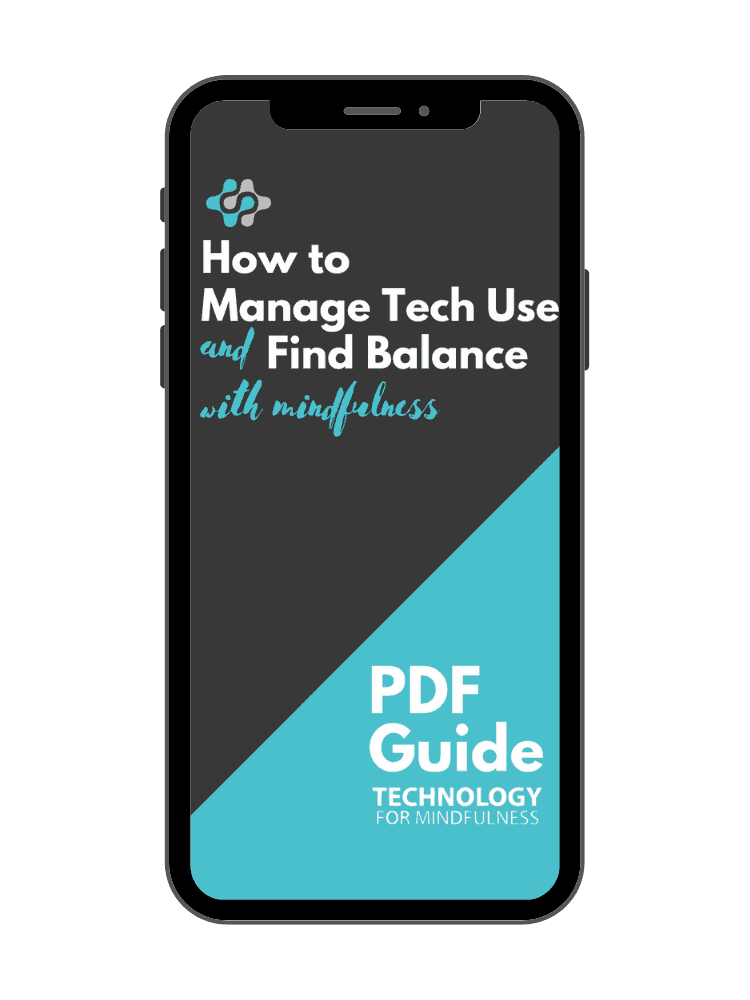Mindfulness exercises can help you manage the effects of daily tech use on your mental well-being and allow you to find balance in daily life, easing stress, developing self-compassion, and providing perspective. Read on to learn 4 exercises to help you do just that.
It was just yesterday that the first iPhone hit the market, and with it, renewed excitement for what the future could hold.
But more than a decade later, we’ve begun to realize that regular tech use– as incredible a quality of life improvement it has been in many ways– has potential negatives as well.
The adoption of smartphones across all aspects of daily life has led to:
- Delayed cognitive development in children
- Disconnect in relationships, and;
- Negative effects on children’s behavior due to distracted parents
And that’s not to mention the effects of social media on perpetuating unrealistic standards and an obsession with perfectionism among teens and adults.
Mindfulness brings balance to the craziness of daily life
Daily life is stressful, hectic, and complicated. But mindfulness has the ability to bring balance to that craziness.
Even a few minutes of practice, done effectively, can make a real difference in not only your mental well-being but your resilience toward future stress.
That’s where these simple mindfulness exercises come in.
4 Mindfulness Exercises to Manage Tech Use and Find Balance
Below are 4 mindfulness exercises that, taken together, can form the basis for an effective practice to help you manage the effects of technology and find balance in daily life.
However, each stands on its own as an effective practice as well, so experiment to find which provide the most benefit to you.
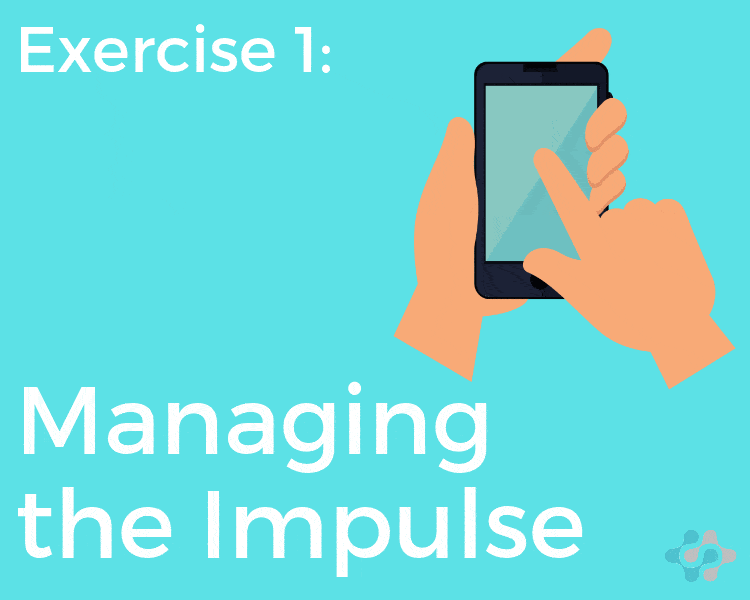
1. Managing the impulse
The first of our 4 mindfulness exercises is about helping you learn more about how your regular tech use is impacting your behavior.
When a chime sounds off on our phone, many of us pull out our phones without even thinking about it. The impulse has become so automatic that we never take the time to question what we’re doing.
If you have 2-3 notifications a day, that’s no big deal. However, when that snowballs– as it often does– to 20-30 (or more) notifications each day, it becomes a real problem.
At that rate, you’re being interrupted from whatever you’re doing several times an hour all day long, every day. That includes when you’re working on an important project at work that requires your full concentration to when you’re blocking out time with your family.
How to practice managing the impulse
To practice managing the impulse, the trick is to follow these steps whenever you:
- Notice yourself reach for your phone when it pings
- Go to click on a notification for an app (from Facebook, etc.) when you’re already in the middle of something else on your phone
- Or when a notification pings on your desktop while you’re working
Follow these steps:
1. Pause
It might sound self-explanatory to pause when you notice one of these impulses arise, but it’s easily the most important part of the practice and therefore needs to be emphasized.
We’ll talk about acknowledging what’s going on and identifying patterns in a moment, but beyond that what you’re really trying to do is break the pattern of behavior the is supporting the impulse.
Each time you consciously pause when you notice the urge to check your phone when it pings, or a similar situation, you take a step toward reworking that unconscious habit.
2. Acknowledge
Next, once you’ve paused, take a moment to acknowledge the thoughts going through your mind:
“Did Jen reply to me?”
“What’s everyone up to?”
“What am I missing?”
Or, it could simply be an emotion:
“Anxiety”
“Anticipation”
“Stress”
Whatever you notice, acknowledging those thoughts and feelings has a kind of power to it. It’s like bringing a problem to the surface.
Admitting there’s a problem is often half (or more of) the battle, so acknowledging that you feel anxious every time your phone pings immediately starts shifting the power back into your hands so you can begin to interact with your tech in a more mindful way.
3. Note down
This last step isn’t required, or at least can be done mentally, but it’s important to start keeping tabs on the different feelings you’re noticing.
You don’t just want to notice the emotions that arise when you’re interacting with these tech-related impulses, you want to identify patterns and get to the root of the problem, and you can only do that by seeing the bigger picture.
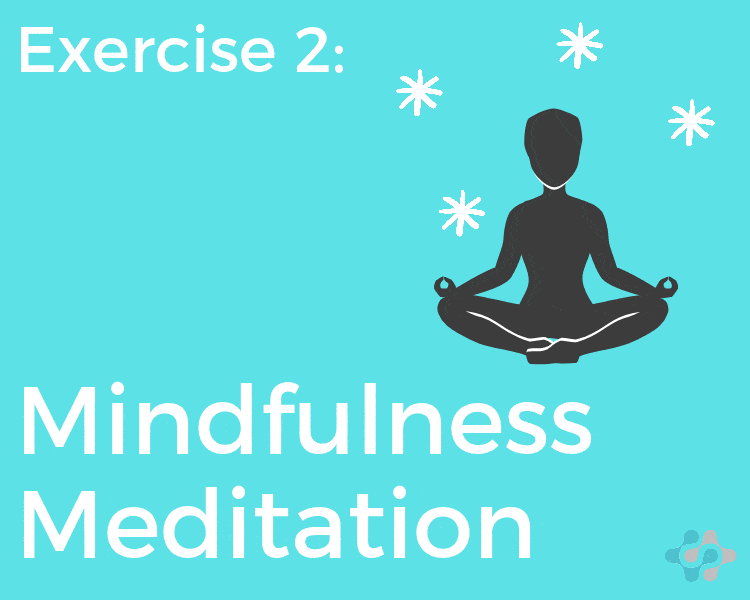
2. Mindfulness meditation
The most basic of mindfulness exercises, think of sitting in meditation as also the most concentrated form of mindfulness practice.
Diving deep into meditation is important– and different from simply being mindful of what you’re doing as you go about your day– because it allows you to uncover and explore your subconscious mind.
The subconscious is the place where your inner dialogue resides, and the more you can enter deep meditation the more you’ll help whatever internal challenges and limiting beliefs you might have risen to the surface.
We often feel and think things in our normal state that go completely unnoticed by our conscious mind.
For example, the icky disappointment, frustration, or envy you might feel after scrolling through your Instagram feed and only seeing a bunch of people who seem to have comparatively “better” lives, bodies, or stuff than you.
Sitting in meditation regularly helps these feelings and thoughts rise to the surface. And awareness is the first, most important, and often only step necessary for dealing with them.
How to practice mindfulness meditation:
To practice mindfulness meditation, find somewhere relatively quiet and private and then follow these steps:
1. Sit
This is a simple step, but it’s important to emphasize that no particular sitting form is necessary. You could even sit in a chair if that’s more comfortable for you (back problems, etc.).
Just sit, straighten your back, then allow yourself to relax a bit and you should rest in a position where your posture is good without being tight or rigid.
2. Turn your attention to your breathing
Now that you’re relaxed, turn your attention to your breathing.
Don’t attempt to control your breathing, even if it’s short or shallow. Simply noticing your breathing will automatically calm your body, mind, and as a result, lengthen and deepen your breaths as a result.
Concentrate from the beginning to the end of each in-breath and out-breath. Focusing on the movement of the breath through your nostrils or the rhythmic movement of the abdomen or chest will help you stay focused.
3. Count your breath
At the end of each out-breath and in-breath, count 1. Continue this count up to 10.
In most cases, you’ll lose focus and fall off your count somewhere early, often between 3-5, gradually and consistently being able to reach higher numbers as you practice more.
Don’t worry, losing focus constantly is perfectly normal in the beginning– even if it seems like you’re losing your concentration every 10-20 seconds.
4. Notice + Refocus your attention
So, you’re losing your attention constantly. Totally normal and nothing to worry about.
In fact, in the beginning, it’s a good thing to notice this. If you’re noticing it, it means your awareness is improving.
But what do you do about it?
Notice the distraction– even if you simply noticed yourself become distracted in general but can’t sense what it was that actually distracted you.
Start by labeling it “distraction”. You’ll gradually move to “thought”, “feeling”, or “sensation” as your awareness improves. And, finally, specific thought: “I’m anxious about the future” or specific emotion: “anger”.
Once you’ve acknowledged what it was that distracted you, refocus your attention on your breathing and continue your count.
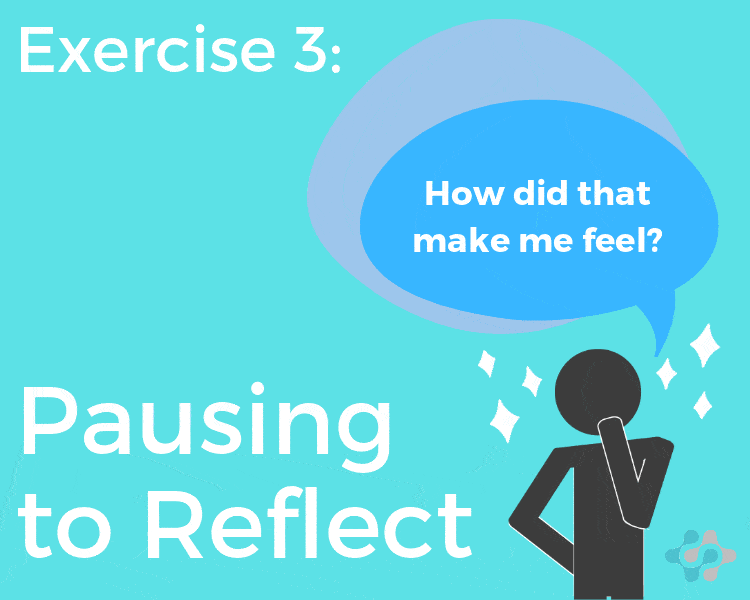
3. Pausing to reflect
Earlier, we talked about managing your tech-related impulses.
In this exercise, we’ll move from a proactive exercise to a reflective one you’d do after ending a particular session (especially a session of distraction) with that same technology.
Once you’re done scrolling through Instagram, how do you feel about yourself? What kind of thoughts revolve within your mind? How does your mood change after spending half-an-hour on Facebook?
These are the kinds of questions you’ll want to ask as you go to put down your device or refocus after becoming distracted.
How to practice pausing to reflect
To practicing pausing to reflect, follow these steps:
1. Pause
Pausing isn’t the important habit-building step that it is in the ‘managing the impulse’ exercise from earlier, but it still serves the same basic purpose otherwise:
instead of rolling into the “next thing” unconsciously (getting back to your work, bringing your attention back to your loved ones, etc.), stop to become aware of the thoughts and feelings that arose in connection with the experience.
This includes:
- Jumping on your favorite smartphone game
- Scrolling through Instagram
- Checking your notifications on Twitter
- Swiping through stories on Snapchat
- Getting sucked into Yahoo!’s endless front page
- Watching YouTube videos
- Or any number of countless tech-related sessions that aren’t entirely productive (and, even when they could be misconstrued as such, noticing that checking your email at 7PM when you’re supposed to be spending time with your kids is ill-timed)
No matter what the experience was, when you catch yourself, take a moment to pause and fight back against your unconscious conditioning.
2. Ask: “How did that make me feel?”
Next, once you’ve put your device down, switched tabs, etc., before moving on, reflect on how that experience with your device made you feel.
Ask: “How did that make me feel?”
Take a moment to turn inward and notice how your body feels. The body often mirrors the thoughts and emotions we have going on within us without us noticing it. But by paying attention for a few moments you can pick up small insights.
For example, you might notice you feel anxious or generally ill-tempered after scrolling through Instagram. Maybe your experience with it is conditioning you to compare your life to one of the countless influencers who appear to have betters lives in every way than you (which, by the way, is almost always a fake representation).
There are all kinds of insights you might notice as a result of asking this question.
3. Experiment
The mindfulness part of the reflecting exercise is simple and easy, but there’s an extra mindfulness-building step that’s essential to making this exercise effective. That extra step is experimentation.
Once you’ve begun practicing pausing to reflect, you may notice certain patterns of thought or feeling when you interact with your chosen piece of tech, including sites, apps, etc.
Continuing with our example, if you notice these negative feelings of anxiety and unhappiness spike every time you use Instagram, see what stepping away from it for the next 2 weeks does for your mental well-being.
You don’t have to stop using it altogether, but consider only checking it once a day at the end of the day on your desktop and delete the app from your smartphone, like vlogger and filmmaker Casey Neistat did:
Whatever you decide is the right action to take, be smart– and brave– and consider what is best for your life and mental health and how your choice could affect your loved ones.
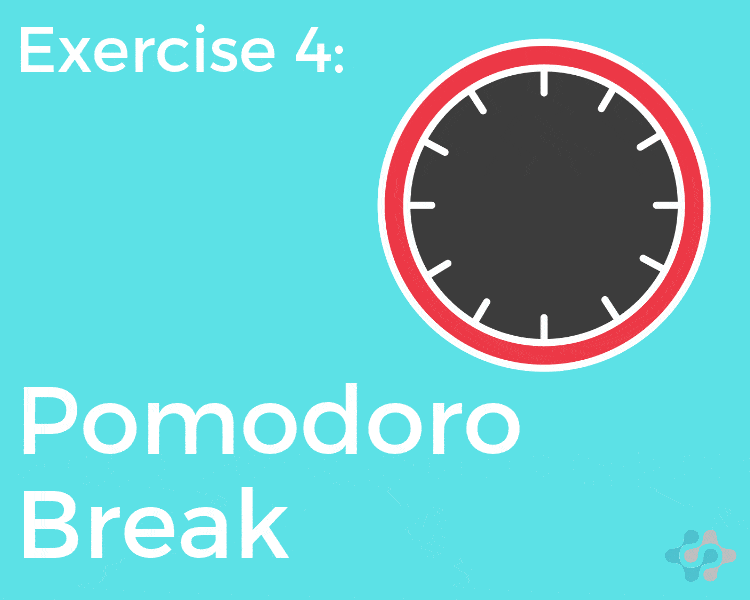
4. Pomodoro break
The Pomodoro method, or the Pomodoro technique, was developed by Francesco Cirillo in the late 1980s.
The technique uses a timer to break down an activity into pieces, from 25-55 minutes in length, which is then separated by regular 5-minute breaks.
The basic idea is this (and it’s been supported in several studies since): By taking regular breaks between any activity, particularly work, you’re more productive than if you were to work straight through without stopping.
That might sound weirdly counterintuitive, but it’s not. The brain works like a muscle, and muscles need regular breaks between reps when you’re working out, otherwise, you’ll tire yourself out faster.
Many of us believe that we can’t afford– or aren’t worth– to stop because we have to work harder to hit our goal. The result is that we work so hard we burn ourselves out and end up less productive than we could have been. Bummer.
You know what else you can use these regular breaks for? Mindfulness. By taking a minute to do some mindful breathing every 1-hour or so of work (or any activity), you can center yourself and start developing more self-awareness, which is critical for improving your mental well-being– and your life as a whole.
How to have a Pomodoro break
This exercise doesn’t have unique instructions, they’re pretty much identical to sitting in meditation:
- Turn your attention to your breathing
- Follow your breath (I suggest just following your breath since the practice will only take you a minute or so)
- Notice
However, where this exercise differs is in time. A Pomodoro break using the mindfulness bell extension, or whatever else you prefer, should only last about a minute.
It’s a quick “check-in” with yourself during your day, however many times during the day you choose to check-in.
The Bell of Mindfulness Chrome extension is nice because you can set a timer to go off every hour, or whenever you prefer, and a traditional Buddhist bell will sound to summon you to mindfulness for about a minute, without you having to remember to take these regular breaks:
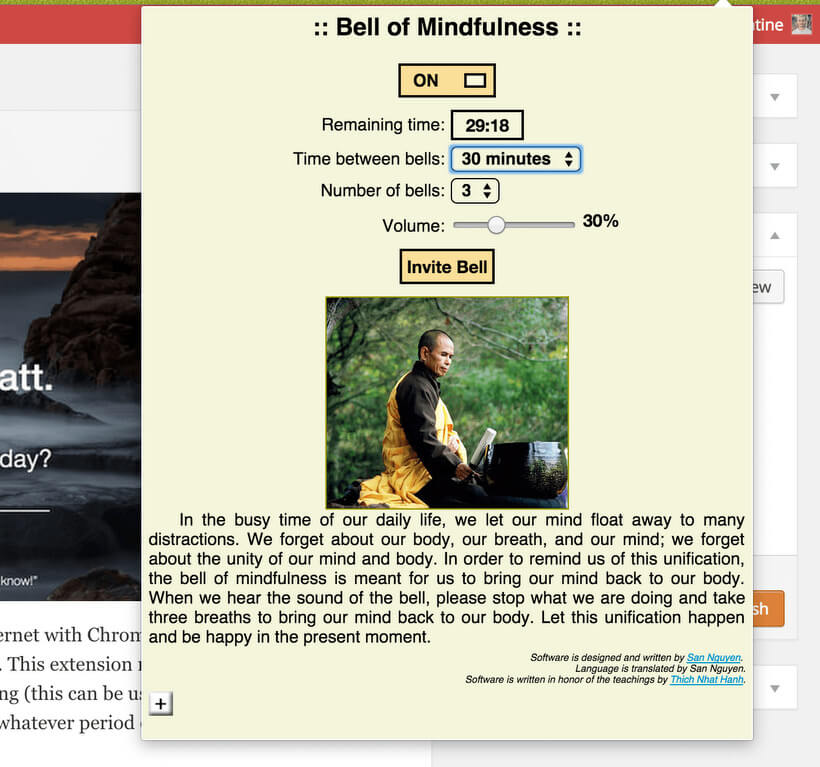
This exercise is unique because it creates little moments of consciousness in what is usually one big blur of a day where work whizzes by, then you head home, pick up dinner, spent time at home, and end your day all in what often feels like the blink of an eye.
It conditions mindfulness throughout your day, which is a skill that takes a lot of work to develop in daily life (at least spontaneously) and helps you check in with how you’re feeling, giving you all kinds of insights that help you create a greater sense of internal balance.
Find balance with mindfulness exercises
Daily life is more complex than ever with the introduction of recent technology.
This has led to some incredible quality of life improvements, among other things, but it’s also led to some negative side effects.
However, mindfulness can help you find the balance necessary to move forward with a clear mind, calm heart, and happier you.
The practices are simple, but it takes work– just as with anything else– to develop a regular mindfulness practice.
Use these mindfulness exercises to help you find balance and invest in yourself to make that practice a reality.

